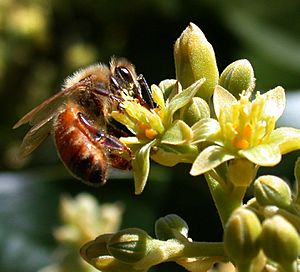Nature's services facts for kids
Nature's services is a cool way to talk about all the amazing things nature does for us humans. These are benefits that we can sometimes even measure in money! In the 1990s, a scientist named Robert Costanza and his team looked closely at how much nature helps people. They studied something called natural capital, which means the natural resources and processes that support life.
They figured out that just seventeen of these "nature's services" were worth about US$33 trillion each year. That's a huge amount! It was even more than the entire human economy at the time, which was around US$25 trillion. They got this number by estimating how much it would cost us to replace these services if nature didn't provide them for free. This study made it super clear that humans really depend on nature's services to grow and thrive.
This important study helped create the idea of natural capital. However, it didn't greatly change how governments, the WTO, the IMF, or the G8 made their economic plans.
Contents
What Are Nature's Services?
Nature's services, also known as ecosystem services, are the many benefits that people get from nature. Think of them as gifts from our planet that keep us healthy and safe. These services are vital for our survival and well-being. They include things like clean air, fresh water, and fertile soil. Without them, life as we know it would be very different.
Types of Nature's Services
There are many different kinds of nature's services. Scientists often group them into four main types:
Supporting Services
These services are the basic ones that make all other services possible. They include things like:
- Nutrient cycling: Nature recycles important nutrients like nitrogen and phosphorus. This keeps soils healthy for plants to grow.
- Soil formation: It takes a long time, but nature creates the soil that plants need to live.
- Photosynthesis: Plants use sunlight to make food and oxygen. This is the base of almost all life on Earth.
Provisioning Services
These are the products we get directly from nature. They are often things we can eat, use, or sell. Examples include:
- Food: All the fruits, vegetables, meat, and fish we eat come from nature.
- Fresh water: Lakes, rivers, and underground sources provide the water we drink.
- Timber: Wood from trees is used for building, paper, and fuel.
- Medicines: Many important medicines come from plants and other natural sources.
Regulating Services
These services help control natural processes and keep our environment stable. They protect us from harm and make our planet livable. Some examples are:
- Climate regulation: Forests and oceans help control the amount of carbon dioxide in the air, which affects our climate.
- Flood control: Wetlands and healthy forests can soak up rainwater, reducing the risk of floods.
- Disease control: Healthy ecosystems can help control the spread of diseases. For example, some animals eat pests that carry diseases.
- Water purification: Wetlands and soil naturally filter pollutants from water, making it cleaner.
Cultural Services
These are the non-material benefits we get from nature. They improve our lives in many ways, even if we can't touch them. These services include:
- Recreation: Enjoying nature through hiking, camping, or just spending time outdoors.
- Spiritual enrichment: Many people feel a deep connection to nature and find peace there.
- Aesthetic beauty: The beauty of landscapes, animals, and plants inspires us.
- Education: Nature provides amazing opportunities for learning and discovery.
Why Are Nature's Services Important?
Understanding nature's services helps us see how much we rely on a healthy planet. When these services are damaged, it can have serious effects on our lives and economies. For example, if forests are cut down, we might face more floods, less clean air, and fewer places for animals to live.
By knowing the value of these services, we can make better choices about how we treat our environment. It encourages us to protect nature, not just because it's beautiful, but because it's essential for our future.
Images for kids
-
Upland bog in Wales, forming the official source of the River Severn. Healthy bogs sequester carbon, hold back water thereby reducing flood risk, and supply cleaned water better than degraded habitats do.
-
Social forestry in Andhra Pradesh, India, providing fuel, soil protection, shade, and even well-being to travelers.
-
Detritivores like this dung beetle help to turn animal wastes into organic material that can be reused by primary producers.
See also
 In Spanish: Servicios del ecosistema para niños
In Spanish: Servicios del ecosistema para niños






